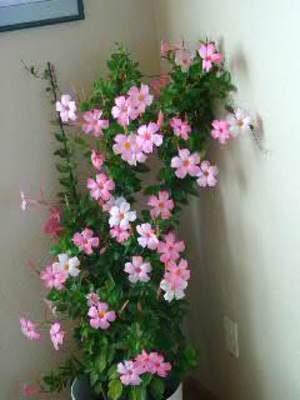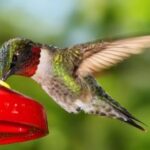The Mandevilla plant is a very attractive flowering plant and when I saw one this spring, I bought it. I thought I’d use it as a container plant on my deck for the summer as the Mandevilla plant is considered to be an annual in most of the country.
The Mandevilla plant comes in two colors, pink and red. I chose the pink Mandevilla plant and when it blooms the color is a pale pink that turns a darker pink as the flower ages. All summer this plant had several different tones of pink and was very attractive. The Mandevilla plant is very easy to care for and attracts hummingbirds with its tubular flowers. The flower is somewhat similar to the hibiscus plant.
The Mandevilla plant should be more popular than it is in homes as it’s very easy to care for and looks stunning inside the house. I’m not sure why the popularity of this plant hasn’t caught on; it should be as popular as a hibiscus plant. It could be the fact that it’s little known and it’s not as common to find in nurseries as the well-known hibiscus plant. I actually found my Mandevilla plant in Walmart as I was strolling through their garden section. I haven’t seen it any of my local garden nurseries.
The Mandevilla plant is also called the Mandevilla vine plant because it is a climber. It can climb 10 ft. or more depending on which species you have. There are over 100 species of this plant. The plant I bought is the Dipladenia sanderi rosa and the vines will grow 10-12 ft. My plant is in a large container pot and I bought a strong metal trellis that fits into the pot. The Mandevilla plant is very easy to train and quickly covered the trellis with its dark green leaves and bright pink flowers. At the end of the summer, you could barely see the trellis under the plant.
History of the Mandevilla Plan
The name of the plant is strange, however, this plant was named after a British gardener, Henry Mandville, who was also a diplomat. This plant was formerly known as the Dipladenia plan
Caring for a Mandevilla Plant Outdoors
The Mandevilla plant can be planted outside in Zones 9-11 and is considered to be hardy for those Zones. That means that most of the United States has to use this plant as an annual. It’s well-suited for containers in other Zones and you can overwinter the Mandevilla plant indoors, so don’t throw it away.
During the summer months, this plant can be kept outdoors with some partial shade especially during the peak heat of the day. Keep the container soil moist, feed it once or twice a month, and it will bloom profusely. As I mentioned, the blooms start out as a light pink color and get darker as they age. As a result, there’s always several different shades of pink on this plant.
Overwintering Your Mandevilla Plant
The Mandevilla plant can withstand temperatures above 40ºF outside. During the fall months when the nights become cooler, it’s wise to harden the Mandevilla plant by taking it indoors for the nights. Bring it back out into the sunshine during the day as long as temperatures are above 50ºF. It should be able to withstand short periods of temperatures in the mid-to-high 40’s, but to be safe, I’d keep it in unless it’s above 50ºF. If you do this for just a few weeks, your Mandevilla plant will be ready to keep indoors for overwintering. If the plant gets too cold, the leaves will turn yellow and drop.
As with any plant, before your bring your Mandevilla plant indoors, check for pests. Mealy bugs, white fly, and aphids are attracted to this plant. Make sure you look on the underside of leaves for any indication of pests. An insecticidal soap spray will do the trick if you see pests.
Feed the plant once more and then cut the plant back about one-third before bringing it into the house if the flowers have died. If not, wait until the flowers die indoors, then trim it back. This will make for a bushier plant and will signal to the plant that it’s time to rest.
Indoor Requirements for Your Mandevilla Plant
Once the weather in your area stays below 50ºF, keep your Mandevilla plant indoors. This plant has simple requirements that are needed to successfully overwinter this plant indoors. It needs bright light with frequent misting while the plant is blooming. Keep it on the dry side while overwintering it and don’t feed it until spring. Temperatures indoors should not go below 55ºF.
When spring comes around again, you’ll need to harden the Mandevilla plant by bringing it outside during the day and taking it back into the house at night. Take your Mandevilla plant outside again when temperatures are above 55ºF. It’s been used to the warmth of your house with average household temperatures in the 60’s, so it’ll need the warmer spring days for hardening.
Next spring, look for one of these beauties and if you see one, don’t hesitate to buy it. The Mandevilla plant is one of the most prolific blooming plants I’ve ever had and looks great as a pot on the deck.
Sources: Gardening Know How
Mandevilla Plant
Hort-Chat.com
Personal Experience







